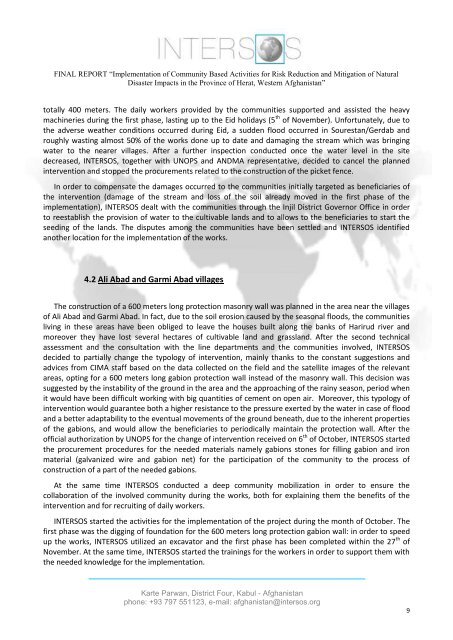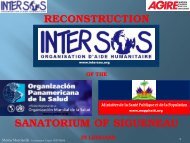Implementation of Community Based Activities for Risk ... - Agire
Implementation of Community Based Activities for Risk ... - Agire
Implementation of Community Based Activities for Risk ... - Agire
Create successful ePaper yourself
Turn your PDF publications into a flip-book with our unique Google optimized e-Paper software.
FINAL REPORT “<strong>Implementation</strong> <strong>of</strong> <strong>Community</strong> <strong>Based</strong> <strong>Activities</strong> <strong>for</strong> <strong>Risk</strong> Reduction and Mitigation <strong>of</strong> NaturalDisaster Impacts in the Province <strong>of</strong> Herat, Western Afghanistan”totally 400 meters. The daily workers provided by the communities supported and assisted the heavymachineries during the first phase, lasting up to the Eid holidays (5 th <strong>of</strong> November). Un<strong>for</strong>tunately, due tothe adverse weather conditions occurred during Eid, a sudden flood occurred in Sourestan/Gerdab androughly wasting almost 50% <strong>of</strong> the works done up to date and damaging the stream which was bringingwater to the nearer villages. After a further inspection conducted once the water level in the sitedecreased, INTERSOS, together with UNOPS and ANDMA representative, decided to cancel the plannedintervention and stopped the procurements related to the construction <strong>of</strong> the picket fence.In order to compensate the damages occurred to the communities initially targeted as beneficiaries <strong>of</strong>the intervention (damage <strong>of</strong> the stream and loss <strong>of</strong> the soil already moved in the first phase <strong>of</strong> theimplementation), INTERSOS dealt with the communities through the Injil District Governor Office in orderto reestablish the provision <strong>of</strong> water to the cultivable lands and to allows to the beneficiaries to start theseeding <strong>of</strong> the lands. The disputes among the communities have been settled and INTERSOS identifiedanother location <strong>for</strong> the implementation <strong>of</strong> the works.4.2 Ali Abad and Garmi Abad villagesThe construction <strong>of</strong> a 600 meters long protection masonry wall was planned in the area near the villages<strong>of</strong> Ali Abad and Garmi Abad. In fact, due to the soil erosion caused by the seasonal floods, the communitiesliving in these areas have been obliged to leave the houses built along the banks <strong>of</strong> Harirud river andmoreover they have lost several hectares <strong>of</strong> cultivable land and grassland. After the second technicalassessment and the consultation with the line departments and the communities involved, INTERSOSdecided to partially change the typology <strong>of</strong> intervention, mainly thanks to the constant suggestions andadvices from CIMA staff based on the data collected on the field and the satellite images <strong>of</strong> the relevantareas, opting <strong>for</strong> a 600 meters long gabion protection wall instead <strong>of</strong> the masonry wall. This decision wassuggested by the instability <strong>of</strong> the ground in the area and the approaching <strong>of</strong> the rainy season, period whenit would have been difficult working with big quantities <strong>of</strong> cement on open air. Moreover, this typology <strong>of</strong>intervention would guarantee both a higher resistance to the pressure exerted by the water in case <strong>of</strong> floodand a better adaptability to the eventual movements <strong>of</strong> the ground beneath, due to the inherent properties<strong>of</strong> the gabions, and would allow the beneficiaries to periodically maintain the protection wall. After the<strong>of</strong>ficial authorization by UNOPS <strong>for</strong> the change <strong>of</strong> intervention received on 6 th <strong>of</strong> October, INTERSOS startedthe procurement procedures <strong>for</strong> the needed materials namely gabions stones <strong>for</strong> filling gabion and ironmaterial (galvanized wire and gabion net) <strong>for</strong> the participation <strong>of</strong> the community to the process <strong>of</strong>construction <strong>of</strong> a part <strong>of</strong> the needed gabions.At the same time INTERSOS conducted a deep community mobilization in order to ensure thecollaboration <strong>of</strong> the involved community during the works, both <strong>for</strong> explaining them the benefits <strong>of</strong> theintervention and <strong>for</strong> recruiting <strong>of</strong> daily workers.INTERSOS started the activities <strong>for</strong> the implementation <strong>of</strong> the project during the month <strong>of</strong> October. Thefirst phase was the digging <strong>of</strong> foundation <strong>for</strong> the 600 meters long protection gabion wall: in order to speedup the works, INTERSOS utilized an excavator and the first phase has been completed within the 27 th <strong>of</strong>November. At the same time, INTERSOS started the trainings <strong>for</strong> the workers in order to support them withthe needed knowledge <strong>for</strong> the implementation.Karte Parwan, District Four, Kabul - Afghanistanphone: +93 797 551123, e-mail: afghanistan@intersos.org9




